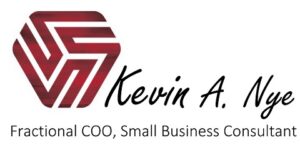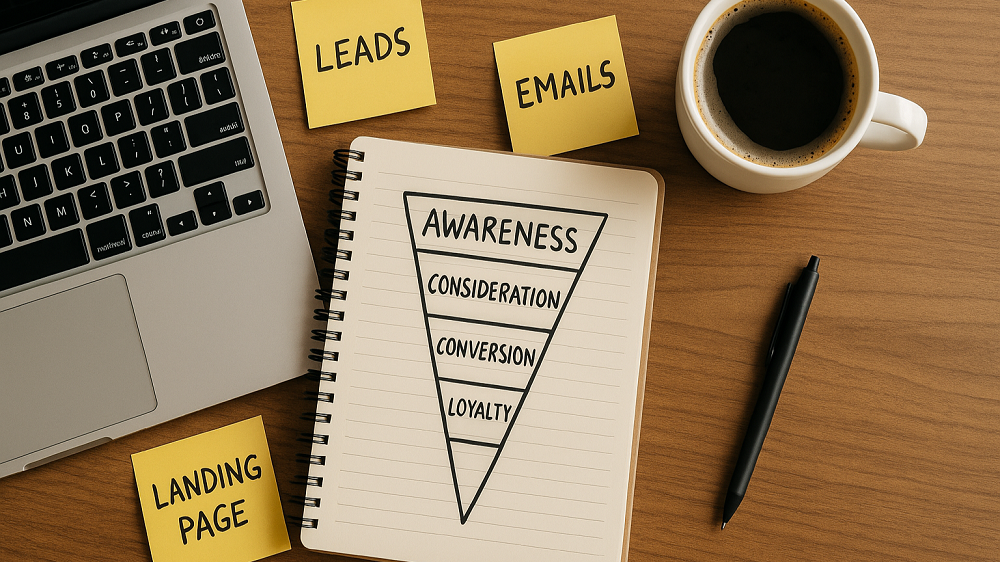Marketing doesn’t have to be complicated, but for many small business owners, it often feels that way. With endless advice on SEO, social media, paid ads, email automation, and content strategy, it’s easy to get overwhelmed. You may find yourself doing a little bit of everything and seeing results from none of it.
That’s usually because there’s no clear funnel in place.
A marketing funnel is simply a step-by-step path that guides someone from being a stranger to becoming a paying customer. When done right, it brings structure to your marketing, saves time, and generates more predictable revenue.
What Is a Marketing Funnel?
A marketing funnel is a model that represents the stages someone goes through before making a purchase. At the top, they’re just becoming aware of your business. At the bottom, they’re buying from you, and ideally coming back again.
Think of it like this:
- Top of Funnel (TOFU): Awareness
- Middle of Funnel (MOFU): Consideration
- Bottom of Funnel (BOFU): Conversion
Each stage has a different purpose and requires different content or actions to move people forward.
Why Most Small Business Marketing Fails
Here’s what often happens with small businesses:
- They post on social media without knowing who they’re talking to.
- They run ads but have no follow-up process.
- They send one-off emails with no clear goal.
- They get leads but don’t nurture them.
- They rely only on word-of-mouth or referrals.
All of this leads to wasted time and inconsistent results.
A proper funnel fixes this by creating a connected journey. Every piece of marketing has a job to do, and each step builds on the one before it.
The 4-Stage Funnel That Works
You don’t need a 12-step, overly technical sales machine to succeed. You just need four stages that work together. Here’s the simple funnel we recommend:
- Attract
- Capture
- Nurture
- Convert
Let’s walk through each step in detail.
Stage 1: Attract (Get Their Attention)
At the top of the funnel, your goal is to make people aware of your business. These are people who don’t know you yet but could be a good fit.
What works at this stage:
- Blog posts that answer common questions
- SEO-optimized website pages
- Social media content
- YouTube videos
- Google or Facebook ads
- Speaking at events or webinars
- Partnerships with other businesses
Pain point: Many small business owners create content that no one sees or run ads that attract the wrong people.
How to fix it:
Start by identifying who your ideal customer is. What problems are they trying to solve? What keywords are they searching for? Tailor your content and ads to that person and that problem.
Stage 2: Capture (Get Them on Your List)
Once someone is aware of your business, your next goal is to capture their contact info so you can continue the conversation.
What works at this stage:
- Lead magnets (free downloads, checklists, guides)
- Newsletter signups
- Free quotes or consultations
- Special offers
- Discount codes
Pain point: Most visitors will never return to your website unless you give them a reason. If you don’t have a way to capture leads, you’re losing potential customers.
How to fix it:
Offer something valuable in exchange for their email. Make it simple and relevant. Avoid long forms or generic messaging. For example:
- “Download our free 7-step checklist to choose the right contractor”
- “Get 10% off your first visit—just enter your email”
- “Schedule your free 15-minute consultation today”
Once you have their info, you’re in control of the relationship.
Stage 3: Nurture (Build Trust)
Most people won’t buy right away. They need time to decide, compare, and feel confident that your solution is the right one. That’s where nurturing comes in.
What works at this stage:
- Automated email sequences
- Personal follow-up messages
- Case studies or testimonials
- Helpful blog content
- Social proof like reviews and success stories
Pain point: A lot of small businesses give up too early or only follow up once. Leads grow cold, and opportunities are missed.
How to fix it:
Use email automation or calendar reminders to stay in touch. Provide value. Share how your business has helped others. Answer common objections. Show up consistently.
This builds trust and positions your business as the obvious choice when they’re ready to buy.
Stage 4: Convert (Make the Sale)
This is where all the hard work pays off. Your lead is informed, interested, and ready to take action. Now it’s time to make it easy to say yes.
What works at this stage:
- A clear and simple offer
- A streamlined checkout or booking process
- Clear pricing and next steps
- Social proof near the buy button
- Urgency (limited spots, time-sensitive deals)
Pain point: Some small businesses lose sales here due to friction. The website is confusing. The offer isn’t clear. Or customers don’t feel confident about the next step.
How to fix it:
Review your sales process from a customer’s perspective. Is it easy to understand? Can someone buy or book in just a few clicks? Is your offer clear and compelling?
You’ve already earned their trust. Now just make it easy for them to take the next step.
Bonus: What Happens After They Buy?
The funnel doesn’t end at the sale. Loyal, happy customers are your best source of future revenue.
After they convert:
- Send a thank-you message
- Ask for feedback or a review
- Offer an upsell or related product
- Invite them to join your referral program
- Stay in touch with regular updates or exclusive offers
A great post-purchase experience builds lifetime value and turns one-time buyers into repeat customers.
Tools to Help You Build This Funnel
You don’t need a big budget or a complex tech stack to make this funnel work. Here are some simple tools you can use:
- Website/landing pages: WordPress, Carrd, Squarespace
- Lead capture forms: Mailchimp, ConvertKit, or MailerLite
- Email automation: ActiveCampaign, Constant Contact, or GetResponse
- CRM/lead tracking: HubSpot (free plan), Zoho CRM
- Social scheduling: Buffer, Later, or Metricool
- Online payments: Stripe, Square, or PayPal
There are also all-in-one platforms for marketing that can simplify your efforts. Choose tools that are easy for you to use and integrate well with your existing setup.
Common Funnel Mistakes to Avoid
- Trying to sell too early: Don’t push your product on someone who just found you. Focus on building value and trust first.
- Skipping the nurture stage: People rarely buy on the first touch. Follow up consistently to stay top of mind.
- No clear next step: Whether it’s signing up, scheduling a call, or making a purchase, your funnel should always guide people to a logical action.
- Overcomplicating it: Keep things simple. One funnel. One offer. One clear message. That’s all you need to start.
Final Thoughts: Simple Funnel, Serious Results
You don’t need a marketing degree to grow your business. You just need a clear path for your leads to follow, from finding you, to trusting you, to buying from you.
This four-step funnel is a simple, powerful system that works for nearly every small business. Once it’s in place, you’ll stop spinning your wheels and start seeing results from your marketing efforts.
Start small. Build one step at a time. Refine as you go.
Before long, your marketing will feel a lot less like guesswork and a lot more like growth.
Sources:
– HubSpot Marketing Blog https://blog.hubspot.com
– Neil Patel https://neilpatel.com
– Mailchimp Resources https://mailchimp.com/resources
– Small Business Administration (SBA) https://www.sba.gov
– ConvertKit Blog https://convertkit.com/blog


